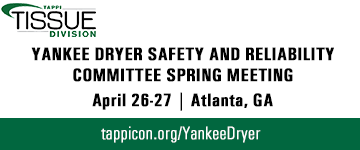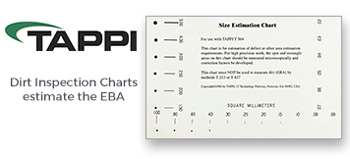 Search
Search
Use the search bar or filters below to find any TAPPI product or publication.
Filters
Content Type
Publications
Level of Knowledge
Committees
Collections
TAPPI Journal
Available at no charge to TAPPI members, each issue of TAPPI Journal features research in pulp, paper, packaging, tissue, nonwovens, converting, bioenergy, nanotechnology or other innovative cellulosic-based products and technologies.
Filtration efficiency and breathability of selected face masks, TAPPI Journal September 2023
ABSTRACT: Face masks have been used as physical barriers to stop respiratory infections for many years. Due to insufficient and low supply of certified masks, alternative face covers such as face
Journal articles

Magazine articles

Effect of fly ash-based calcium silicate on physical properties of cardboard paper, TAPPI Journal July 2023
Setting priorities in CNF particle size measurement: What is needed vs. what is feasible, TAPPI Journal February 2023
ABSTRACT: Measuring the size of cellulose nanomaterials can be challenging, especially in the case of branched and entangled cellulose nanofibrils (CNFs). The International Organization for Standardization, Technical Committee 6, Task Group 1—Cellulosic Nanomaterials, is exploring opportunities to develop standard methods for the measurement of CNF particle size and particle size distribution. This paper presents a summary of the available measuring techniques, responses from a survey on the measurement needs of CNF companies and researchers, and outcomes from an international workshop on cellulose nanofibril measurement and standardization. Standardization needs differed among groups, with Japanese companies mostly requiring measurements for product specification and production control, and other companies mostly needing measurements for safety/regulatory purposes and for grade definitions in patents. Among all the companies, average length and width with percen-tiles (D(10), D(50), D(90)) were the most desired measurands. Workshop participants concurred that defining the location(s) on the CNF at which to measure the width and the length is an urgent and complex question. They also agreed that methods are needed for rapid particle size measurement at the nanoscale. Our recommendation within ISO is to start work to revise the definition of CNFs and develop sample preparation and measurement guidelines. It was also recommended that further research be done to reproducibly prepare hierarchical branched CNF structures and characterize them, develop automated image analysis for hierarchical branched CNF structures, and develop a classification system encompassing measurements at multiple size ranges from micro- to nanoscale to fully characterize and distinguish CNF samples.
The Influence of the Fine Structure of Cellulose on the Action of Cellulases, TAPPI Journal June 2022
ABSTRACT: In the hydrolysis of cellulose with enzymes of Aspergillus niger at 47°C., it shown that a great decrease in the rate occurred in the late stage of the reaction, usually with considerable cellulose still reamaining undissolved.
Web instability in the open draw and the impact on paper machine efficiency, TAPPI Journal May 2022
ABSTRACT: Paper is most likely to break in the first open draw on a paper machine where it is unsupported, wettest, and weakest. Tension is applied to peel the web from the roll surface, as well as minimize web flutter in the open draw. The average tension is well below the breaking point and is often set by adjusting the speed difference between the press and the next machine element by visually observing the behavior of the web. However, machine direction variations caused by instabilities in the paper machine can cause tension swings that exceed the strength of the web. Measurement of the web’s release point from press rolls on pilot and commercial paper machines was used to identify the cause of tension instabilities. Variations in the speed of the paper machine drives and the work of adhesion from the press roll surface were identified as key factors. Fluctuations of paper moisture, which affects the elastic modulus and strength of the web, appear to be less important.
Journal articles

Magazine articles

Experiments and visualization of sprays from beer can and turbo liquor nozzles, TAPPI Journal February 2022
ABSTRACT: Industrial scale swirl-type black liquor nozzles were studied using water as the test fluid. Simple water spraying experiments were found to be very beneficial for studying and comparing nozzles for black liquor spraying. These kinds of experiments are important for finding better nozzle designs. Three nozzle designs were investigated to understand the functional differences between these nozzles. The pressure loss of nozzle 1 (“tangential swirl”) and nozzle 3 (“turbo”) were 97% and 38% higher compared to nozzle 2 (“tan-gential swirl”). Spray opening angles were 75°, 60°, and 35° for nozzles 1, 2, and 3, respectively. Video imaging showed that the nozzles produced sprays that were inclined a few degrees from the nozzle centerline. Spray patter-nation showed all the sprays to be asymmetric, while nozzle 2 was the most symmetric. Laser-Doppler measure-ments showed large differences in spray velocities between nozzles. The spray velocity for nozzle 1 increased from 9 m/s to 15 m/s when the flow rate was increased from 1.5 L/s to 2.5 L/s. The resulting velocity increase for nozzle 2 was from 7 m/s to 11 m/s, and for nozzle 3, it was from 8 m/s to 13 m/s. Tangential flow (swirl) directed the spray 6°–12° away from the vertical plane. Liquid sheet breakup mechanisms and lengths were estimated by analyzing high speed video images. The liquid sheet breakup mechanism for nozzle 1 was estimated to be wave formation, and the sheet length was estimated to be about 10 cm. Sheet breakup mechanisms for nozzle 2 were wave formation and sheet perforation, and the sheet length was about 20 cm. Nozzle 3 was not supposed to form a liquid sheet. Nozzle geometry was found to greatly affect spray characteristics.
Journal articles

Magazine articles

Editorial: Looking forward, looking back, TAPPI Journal January 2022
ABSTRACT: Much like 2020, 2021 was another year of remarkable highs and lows delivered by the COVID-19 pandemic. Vaccines, variants, and infection surges altered the way we behaved personally and professionally last year. As we move into 2022, we are now grappling with health and business concerns from the omicron variant that has overwhelmed hospitals in some areas and contributed to a global supply chain crisis. The ability to adjust has once again become a key skill in adapting to our shifting “new normal.”
Journal articles

Magazine articles

Displacement washing of softwood pulp cooked to various levels of residual lignin content, TAPPI Journal September 2021
ABSTRACT: This study investigates the influence of the degree of delignification of kraft spruce pulp cooked at seven different kappa numbers, ranging from 18.1 to 50.1, on the efficiency of displacement washing under laboratory conditions. Although the pulp bed is a polydispersive and heterogeneous system, the correlation dependence of the wash yield and bed efficiency on the Péclet number and the kappa number of the pulp showed that washing efficiency increased not only with an increasing Péclet number, but also with an increasing kappa number. The linear dependence between the mean residence time of the solute lignin in the bed and the space time, which reflects the residence time of the wash liquid in the pulp bed, was found for all levels of the kappa number. Washing also reduced the kappa number and the residual lignin content in the pulp fibers.
Journal articles

Magazine articles

Editorial: Agility and adaptation in a dynamic business world, TAPPI Journal January 2021
ABSTRACT: As we move into 2020, it's interesting to look back at the research topics that were covered in TAPPI Journal (TJ) the previous year. Members of the TJ editorial board organized diverse special issues on lignin, coating ,forming, and diverse papermaking and biorefinery topics, which are discussed in the following sections.





